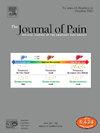"它让你的身体从疼痛的想法中解放出来":以混合方法探索农村社区使用大麻止痛的模式、背景和经验
IF 4
2区 医学
Q1 CLINICAL NEUROLOGY
引用次数: 0
摘要
美国成年人越来越多地报告使用大麻来控制慢性疼痛,而农村地区的综合疼痛管理不足。我们采用混合方法,旨在了解一些农村成年人如何以及为何使用大麻止痛,包括在与阿片类药物共同使用的情况下。参与者(N = 14,俄克拉荷马州)是居住在农村的成年人,每周使用烟草和≥1 种其他物质(包括大麻和阿片类药物)≥3 天。参与者完成了 14 天的药物使用生态即时评估(EMA),并在随后的深入访谈中讨论了他们的药物使用报告图。半数参与者(7/14)描述使用大麻治疗慢性疼痛,其中大部分(85%)报告在≥75%的 EMA 天使用大麻。最常报告的大麻使用动机是治疗/药用(占使用报告的 90%)。大多数报告是在家中吸食燃烧大麻(占吸食报告的 88%)(占吸食报告的 99%)。同日使用大麻和类阿片的情况比较普遍(占每日调查的 45%),但似乎不是在时间上很接近的情况下。访谈叙述将大麻描述为改变与疼痛相关的因素(如思想),而不是消除疼痛本身。他们讲述了使用一系列药物来控制不同的疼痛维度(例如,强度、质量),并平衡不同药物之间的权衡。据参与者描述,医用大麻的使用率很高,但疼痛专科医生的使用率却很低,而且大多数医生都不愿意讨论大麻治疗疼痛的问题。研究结果表明,农村患者可以从更多的综合疼痛治疗中获益,疼痛治疗提供者可以在讨论中讨论大麻问题,而且必须更好地确定使用大麻治疗疼痛的风险和益处。 Perspective 这项研究采用了一种地理明确的 EMA 混合方法,收集了俄克拉荷马州农村地区使用大麻和共同使用大麻治疗慢性疼痛的丰富、密集的试点数据。它提供了独特的见解,为今后研究农村居民这一易受伤害且未得到充分研究的成年疼痛患者亚群的大麻使用情况提供了参考。本文章由计算机程序翻译,如有差异,请以英文原文为准。
“It frees your body from that pain thought”: A mixed-methods exploration of patterns, contexts, and experiences of cannabis use for pain in rural communities
U.S. adults increasingly report using cannabis to manage chronic pain and rural areas have inadequate comprehensive pain management. Using mixed methods, we aimed to understand how and why some rural adults use cannabis for pain, including within the context of co-use with opioids. Participants (N = 14, Oklahoma) were rural-dwelling adults who used tobacco and ≥1 other substance, including cannabis and opioids, ≥3 days per week. Participants completed 14 days of ecological momentary assessment (EMA) regarding substance use and subsequent in-depth interviews discussing maps of their substance use reports. Half (7/14) described cannabis use for chronic pain, and most of these (85%) reported use on ≥75% of EMA days. The most frequently reported cannabis use motive was therapeutic/medicinal (90% of use reports). Most reports were of combusted cannabis (88% of use reports) at home (99% of use reports). Same-day use of cannabis and opioids was relatively common (45% of daily surveys), but seemingly not within close temporal proximity. Interview narratives characterized cannabis as modifying pain-adjacent factors (eg, thoughts), not eliminating pain itself. They recounted using a repertoire of substances to manage different pain dimensions (eg, intensity, quality) and balance perceived trade-offs of different substances. Participants described high medical cannabis access, low pain specialist access, and most physicians as unwilling to discuss cannabis for pain. The findings suggest that rural-dwelling patients could benefit from increased access to comprehensive pain management, having cannabis addressed within pain management provider discussions, and that risks and benefits of cannabis use for pain must be better established.
Perspective
This study used a geographically explicit EMA mixed method to gather rich, intensive pilot data on cannabis use and co-use for chronic pain in rural Oklahoma. It provides unique insights to inform future research on cannabis use among a vulnerable and understudied subgroup of adults with pain—rural residents.
求助全文
通过发布文献求助,成功后即可免费获取论文全文。
去求助
来源期刊

Journal of Pain
医学-临床神经学
CiteScore
6.30
自引率
7.50%
发文量
441
审稿时长
42 days
期刊介绍:
The Journal of Pain publishes original articles related to all aspects of pain, including clinical and basic research, patient care, education, and health policy. Articles selected for publication in the Journal are most commonly reports of original clinical research or reports of original basic research. In addition, invited critical reviews, including meta analyses of drugs for pain management, invited commentaries on reviews, and exceptional case studies are published in the Journal. The mission of the Journal is to improve the care of patients in pain by providing a forum for clinical researchers, basic scientists, clinicians, and other health professionals to publish original research.
 求助内容:
求助内容: 应助结果提醒方式:
应助结果提醒方式:


